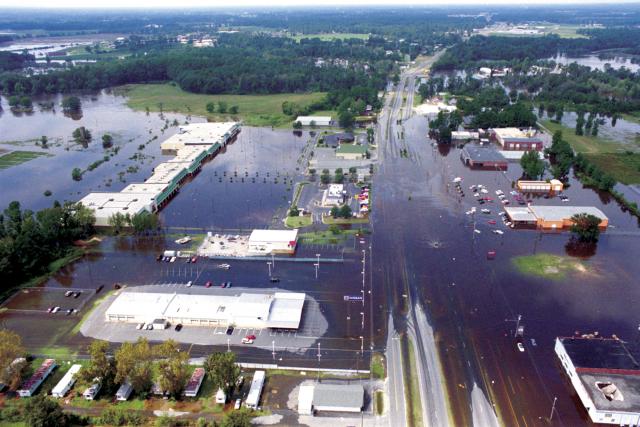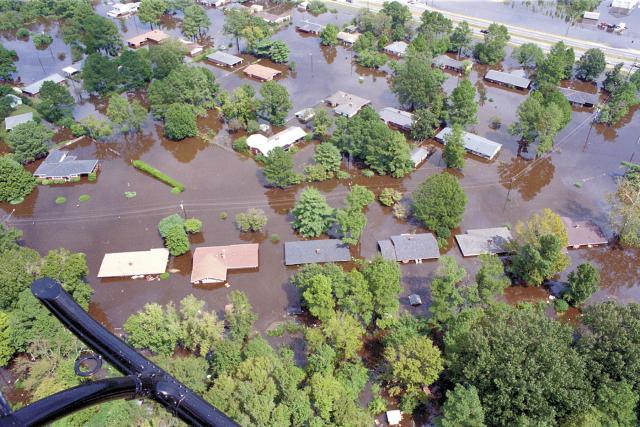Remembering Floyd -
Local lessons
By MATTHEW WHITTLE
Assistant News Editor
For Wayne County, Hurricane Floyd set the bar for emergencies and emergency response. Today, said county emergency services director Joe Gurley, everything they do essentially comes out of those lessons learned.
“We learned a lot. Floyd raised the bar,” Gurley said. “The majority of any plans we have that are hurricane related or rescue management related are based on Floyd.”
••
Floyd arrived in Wayne County at about midnight, Sept. 16, 1999, packing sustained winds of about 45 miles per hour. However, the lack of high winds didn’t mean the county was in the clear as the storm dumped between 14 and 17 inches of rain on grounds already saturated and rivers already swollen by the effects of earlier rains.
Still, Gurley said, that initial blow was fairly “typical” for a tropical weather event, though he admitted it was probably “better we didn’t see it.”
The problems, however, began to become clear the next day as they realized the rivers were continuing to rise.

Eventually, on Sept. 20, the Neuse River crested at 28 feet, nine inches at Arrington Bridge.
“We saw floodwaters in places we’d never seen floodwaters,” Gurley said.
Fortunately, though, he explained, because it took time for the river to crest, county emergency workers had time to go door-to-door to warn residents — many of whom listened — that it was time to pack up and move toward higher ground.
“The unique part about river flooding, if the river gauges are working properly, is you do get time in advance to warn people. We had some who probably didn’t think it would ever reach the level it did,” Gurley said. “But those people, when you told them that it was going to exceed that level (26 feet with Hurricane Fran in 1996), they listened and got out, though there were some who stuck it out.”
••
Eventually, about 10 percent of the county would be underwater, mostly around the Neuse River, the Little River, Falling Creek and other tributaries.
Hit the hardest were Seven Springs and the Mar Mac community, the latter of which, Gurley said, was where the majority of calls for help came from.

“Probably Mar Mac because of the population there,” he said. “A lot of the people there had not experienced a flood before.”
And indeed, said county planning director Connie Price, that area had been the site of a lot of new building in the 1960s and early 1980s — before the passage of the National Flood Insurance Program in 1983, which created the flood zone maps, and the local adoption of flood-specific building rules in 1991.
That meant, Price said, that none of those new homes were elevated, and that many were built within the flood plain.
However, in the other hard-hit areas of the county, with the exception of Seven Springs, which lies almost entirely within in the flood plain, many long-time locals knew where flooding was prone to occur and built elsewhere. Gurley also said that once flooding did begin to occur, people living in areas such as those around West Ferry Bridge and the Neuse Isles to the west, and East Broadhurst Bridge and Seven Springs to the east, had much more knowledge of what to expect.
“Those locals kind of knew,” Gurley said. “Those kinds of people take care of themselves. They normally won’t call you.”
But for those people who did call, he continued, Wayne County was as prepared as it could have been.
Coordinating efforts from the Emergency Operations Center at the old county administration building, Gurley said one thing he will never forget from Floyd are the 19 consecutive days the EOC was running for 24 hours a day. All total, the command center was open for 33 days.
••
And that, Gurley said, is where many of the lessons learned in Floyd have been implemented.
“It’s really a matter of resource management,” he said. “One of the biggest components to any response is resource management.”
Since 1999, the biggest changes as far as the county’s resources are concerned, he explained, have been the creation of the combined, paid EMS department and the creation of the new 911 call center. The move of emergency services into the Jeffries Building also has helped, he added, because it has allowed the county to have a dedicated command center that can be fully operational within 15 minutes.
But, Gurley said, perhaps the most important improvement since 1999 is in terms of communication and information.
For example, new software is available in the communications center that shows secondary routes if primary roads are flooded out. In 1999, they had to depend on local volunteer firemen to help direct crews to open roads, as well as to tell them where the next problem area might be — a perspective that Gurley said is still valuable. Work also is being done to install a new radio system so that every responder in Wayne County can more easily talk.
Additionally, Gurley said, the Internet, e-mail and systems like the Code Red phone notifications now allow the county to more easily and more quickly pass information along to people in case of an emergency. The Internet and other technology also allows the National Weather Service to better model scenarios and share that information.
But, Gurley admitted, while the county is making full use of all the new technology available, he still keeps his file of notes — his historical knowledge — from Floyd handy.
“We have new tools in place and more assets, but we really haven’t tested it all. We’ve had some small events and have activated the EOC, and it worked great, but we haven’t put it to a full test,” he said. “Technology is nice, and it’s good, but a little pencil and paper will get you out of a bind. When the next hurricane comes, I’ll go to my Hurricane Fran file and my Hurricane Floyd file and my scribbles and make sure we’re not leaving anything out.”
••
And, said National Weather Service warning coordinator Jeff Orrock, another Floyd could happen.
“They say it was a 500-year flood, but that doesn’t mean it’s going to be another 490 years, it just means there’s a very low probability every year it will happen again — less than 1 percent,” he said.
But, he continued, even Floyd itself wouldn’t have been that bad if it hadn’t been for Hurricane Dennis and another storm system saturating the ground and swelling the rivers with nearly 10 inches of rain in the preceding weeks.
“We were in a pretty severe drought. I think if you’d had just Floyd and nothing else had happened, the river flooding wouldn’t have been much worse than Fran,” Orrock said. “But those other storms really set the stage for what was to come.”
And, he added, North Carolina actually dodged a bullet when Hurricane Irene skirted the coast instead of barreling inland two weeks after Floyd.
But, he continued, the possibility of another major storm or series of storms still exists.
“Are we due? I guess we are kind of due for another big hurricane on the North Carolina coast,” he said. “And you’ve got to be concerned about complacency and new populations.
“Human nature tends to equate one hurricane with the next, and that can really get you in trouble. Every storm is different.”
••
Fortunately, though, because of Hurricane Floyd, local officials do not expect another similar storm event to cause the same amount of damage.
Many of the areas that saw extensive home damage, such as those around the Mar Mac community and in Goldsboro, are no longer inhabited after FEMA and the state spent approximately $15.5 million buying out many of the properties, with only a handful of people deciding to remain.
Additionally, Price explained, the county has adopted several ordinances that have limited construction in areas prone to flooding.
One of those says subdivisions cannot be built in flood plains. Another, while allowing people to build in a flood plain on their own property, requires houses to be elevated at least two feet above the base 100-year flood level. That same ordinance also allows commercial structures to be constructed in flood plains, but only if they are built to flood-proof standards, with electrical and other equipment raised off the ground and flood vents installed to allow water to run in and out.
And so far, Price said, none of those requirements have really been an issue for the county in terms of restricting development or growth.
“Most of the flood plain is still real rural,” he said. “If we were more urbanized and the flood zone maps made up a greater percentage of the county, there might be more of an effort to build there, but we’ve got a lot of land outside of the flood zones.
“We think we’re regulated for the 100-year flood. It’s reasonable to expect that if we have another Floyd, we’ll be OK. By getting those houses out of harm’s way, and the property now being owned by the county (or city), and by having the ordinance in place that you can’t go in and build a subdivision, the next flood we do have will be much less of a disaster for Wayne County.”
